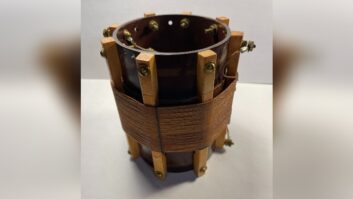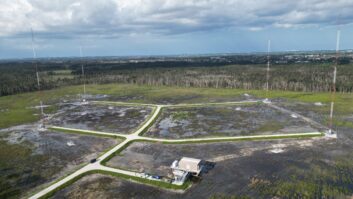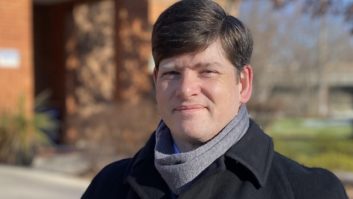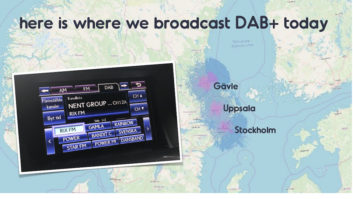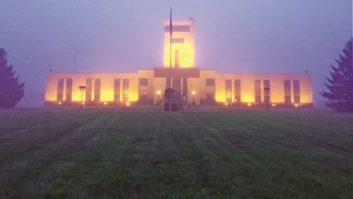
The power increase discussion comes even as numerous LPFMs from the most recent window have CPs but are not yet on the air, including WIZU(LP) in Newark, Del., where Stephen Worden works the mic in a photo from Radio World’s recent eBook “LPFM on Fire.”
Credit: Kirk Smith/The Review WASHINGTON — A power-increase proposal is stirring new debate about low-power FM broadcasters and has LPFM and translator advocates again taking up positions on the subject.
Through a petition for rulemaking, REC Networks asked the Federal Communications Commission to consider allowing eligible 100-watt LPFM stations to boost power to 250 watts in order to increase building penetration and overcome the effects of multipath in their coverage areas. REC also seeks other benefits for LPFMs including second-adjacent channel protections from FM translators and boosters.
QUICK EXPANSION
Low-power FM stations currently broadcast at a maximum of 100 watts and typically reach a radius of approximately 3-1/2 miles from the antenna. They must be licensed to non-profit entities and often are operated by community groups, schools and churches.
Translators, which rebroadcast the signal received from a primary AM or FM radio station on a different frequency, have a maximum allowed ERP of 250 watts, though many operate below that power due to other technical restrictions.
The LPFM service has been expanding thanks to the Local Community Radio Act, signed by President Obama after passage by Congress in late 2010. The LCRA explicitly authorized the FCC to license additional local low-power FM radio stations. In addition, it eliminated third-adjacent channel LPFM spacing requirements and allowed for the commission to create standards for waiving second-adjacent channel protection requirements.
There were 1,202 LPFM stations licensed to be on the air as of mid-July, according to FCC data, compared to 814 at the mid-point of 2014. The number is expected to grow considerably as the FCC finishes working through 2,819 applications filed in the LPFM window in 2013, and as stations with construction permits go on the air. A July search of the FCC database for LPFM stations with “CP Off Air” returned 1,468 results, though it’s unknown how many LPFM CP holders will make it through the process of both getting on air and then staying on.
PRIOR EFFORTS
REC Networks is a community radio advocate that provides a variety of LPFM services. Its founder Michelle Bradley estimates that 50 to 75 percent of LPFM stations would be able to upgrade to LP-250 under the proposal.
LPFM advocates have tried before to add power to the service. The Amherst Alliance filed a similar petition in 2013 asking the commission to consider allowing LPFMs to broadcast at between 101 and 250 watts. But the FCC did not solicit public comments for that request.
Does its willingness to seek comment now mean a higher chance of adoption? One observer familiar with these developments said it’s difficult to gauge the seriousness with which the commission takes a proposal based on whether it has been put out for comments. “The FCC could be being pressured by a special interest group, either directly or through Congress or the administration, to move forward with the petition,” the observer said.
Previous LPFM proposals also restricted upgrades to rural stations; the latest petition called for no geographic restrictions, according to Bradley, though lack of available spectrum in larger urban areas would probably exclude LP-250 there, especially if the FCC were to schedule an FM translator window prior to a power increase.
REC’s petition also asked that the FCC allow certain relocation requests to be treated as minor moves — for 100-watt LPFM stations, up to 6.9 miles; and for upgraded LP-250 stations up to 8.7 miles.
The second-adjacent channel protection requirements in the REC proposal “fixes an inequality between LPFM rules and the translator rules,” Bradley said. “Currently, a translator can come into the second-adjacent channel of an LPFM but an LPFM cannot come into the second-adjacent of a translator without asking for a waiver.”
Advocates for commercial full-power radio disagree with most aspects of the REC proposal, including the call for protection parity with FM translators.
The National Association of Broadcasters in its comments called the request by REC Networks “premature.” It asked the commission to wait until regulators can fully assess the interference impact from the many 100-watt LPFM stations approved out of the 2013 window.
“NAB support for our compromise with the LPFM community a few years ago was premised on the understanding that these stations would remain at 100 watts. Not 150 watts. Not 200 watts. And not 250 watts,” said Dennis Wharton, NAB executive vice president of communications.
“Interference with incumbent radio stations is a very real issue, made even more dramatic with a 250- rather than a 100-watt station.”
TRANSLATOR DEMAND
Some 500 groups and individuals filed public comments on the petition for rulemaking. NAB was one of only a few that voiced opposition, according to Sanjay Jolly, policy director for Prometheus Radio Project, which builds and supports community stations.
Jolly said NAB’s suggestion that the FCC wait to act on a commonsense, evidence-based and widely supported improvement to the LPFM service seems to be an effort to kill the measure by “delaying it out of existence.”
LPFM proponents said NAB seems mainly concerned that if the FCC were to allow LPFMs to increase to 250 watts before the next FM translator window, it would likely limit opportunities for more AMs to apply for translators, something that has been proposed to the FCC in the separate “AM revitalization” initiative.
Indeed, said Wharton, “In markets where the FM band is crowded, increasing LPFM power would leave no room on the radio dial for translators for AM radio stations. Some AM radio station operators have waited years to apply for an FM translator, and the FCC has an ongoing proposal that might open an FM translator window exclusively for AM broadcasters. The commission should address translators for AM radio before jumping into an LPFM proceeding that could crowd out AM radio stations from a rightful place on the FM band.”
The FCC changed its rules and policies several years ago to allow FM translators in certain circumstances to re-broadcast the signals of AM stations and HD sub-channels. That development has turned translators into an even more highly sought after commodity, observers said. Some AM advocates now want to broaden the practice even more.
NAB stated in its comments that demand for translators “currently far outstrip[s] supply, creating untenable bidding wars.” It cites reports of FM translators selling for $30,000 in rural and small markets and for as much as $50,000 in mid-sized and suburban markets, and said some AM owners could be priced out of the market.
WHAT NEXT?
Wharton said it is unclear what the FCC will do next on the LP-250 idea. He said that if the commission releases a notice of proposed rulemaking, NAB would be an active participant throughout the process.
“We do view a rulemaking as premature since the commission has not finished processing all of its approved LPFM applications, and a majority of the approved LPFMs have not yet started operating or even been built,” Wharton said.
In replies to NAB’s assertions, REC Networks told the FCC there is a sufficient sample size. Bradley said 412 LPFM stations from the latest window have completed construction. “What the NAB also ignores are the 773 licensed low-power stations that are still around from the original LPFM filing window in 2000–2001.”
REC Networks also disputes the NAB’s “slippery slope” theory regarding LPFM. Some opponents are worried that other LPFM proponents will ask the FCC for additional power increases in the future.
“At what point does LPFM cease to be considered low power?” one commenter asked.
NAB also argues that Congress did not provide for LP-250 service in the LCRA in 2010.
Tracy Rosenberg, executive director of Media Alliance, discounted that. “There is certainly no codification or mandate contained in the LCRA prohibiting LP-250 service or even for that matter prohibiting LP-50 service.”
Bradley emphasized that the REC Networks proposal says nothing about creation of new stations, but also that “Section 5 of the LCRA literally has designed a regime where FM translators and LPFM ‘take turns’ at obtaining spectrum. With the expiring construction permits that have not asked for extensions, this will open up more spectrum for translator applicants if the FCC opens this window in late 2015 or 2016. It is my hope there will be another LPFM filing window around 2018 or 2019,” she said.
Media Alliance, which advocates for a “free, accountable and accessible media system,” expects the LP-250 issue will move into a full rulemaking with another round of comments and replies from both sides as well as the public.
“I think it is clear that the NAB’s earlier panics about interference were largely unwarranted, so it probably comes down to an assessment of the translator issue,” Rosenberg said. “LP-250 advocates will likely need to present some solutions for maintaining translator availability despite new LPFM expansion applications.”
Don Schellhardt, a longtime backer of LPFM, said, “The NAB points to various problems that could supposedly arise if LP-250s are licensed. However, if these problems could materialize at all, they seem likely to materialize only in areas with moderate to severe spectrum scarcity,” Schellhardt wrote.
Schellhardt and Nick Leggett were the first to petition the FCC in 2013 to consider allowing LPFMs to broadcast at between 101 and 250 watts in mostly rural areas, he said.
INTERFERENCE
TIME SHARE ISSUE
REC Networks founder Michelle Bradley said a proposal regarding LPFM time-sharing arrangements was “the most misunderstood aspect” of RM-11749.
“What we are proposing is that LPFM stations that are operating under a time share agreement and are subject to the local programming pledge as a result of the outcome of their MX group should be permitted to operate a prorated amount of local programming per day based on the number of hours they are authorized to broadcast,” she said.
“Since unlimited stations are authorized to operate 24 hours in a day and the pledge is for 8 hours per day, which is one-third of the authorized hours, REC feels that it makes sense to apply that one-third number across the board. Therefore, if a station is only authorized to broadcast 12 hours per day due to a time share agreement, then the station would only have a pledge for 4 hours a day, where a station authorized 8 hours per day would have a minimum pledge of 2 hours and 40 minutes per day,” she continued.
“We need to keep in mind that the other station that shares the channel would be subject to the same requirements so therefore, the public will still receive a minimum of 8 hours per day of local programming on the shared channel collectively among all of the time share partners. Under the current rules, a station subject to pledge and in an involuntary three-way time share [something they did not know was going to happen in their case] would have to present their entire program day as local programming. Even one newscast that was produced from more than 10/20 miles away would put the station out of compliance. The FCC has already made determinations in the past that a mix of non-local programming with local programming does not deplete the localism of a station.”
Interference concerns sparked comments in the docket from several filers, including Educational Media Foundation, a non-profit organization that operates both full-power stations and translators.
“The commission should only initiate a formal rulemaking in connection with the petition, where, as part of the proceeding, the commission considers the interference that will be caused by LPFM stations, both under current processing standards and under those proposed by REC,” wrote David Oxenford, an attorney representing EMF.
The FCC will have to decide if those interference standards meet the requirements of LCRA and the public interest, Oxenford concluded.
EMF, which uses translator stations for its Christian music networks K-Love and Air1, said it understands the LPFM community’s desire for more power, but asked the FCC for a full review of interference rules so that LPFMs are held to the same standard as translators in that regard.
The organization also said the FCC should manage carefully both the LPFM service and the expectations of those filing for it. “By its very nature, the LPFM service is targeted to those who have little experience in the operation of radio stations, and the realities of LPFM operations can be a surprise to broadcasting novices.”
Asked for comment on interference concerns, Bradley told Radio World, “One thing to remember is that a decade prior to the LCRA, the commission had imposed a ‘buffer zone’ of 20 km around the maximum service contours of all domestic full-power facilities. The intention at the time was to permit full-power stations to be able to move sites with no interruption to the LPFM station.
“The LP-250 proposal will not add any additional interference to full-power stations by most LPFM stations,” she continued. “For a small number of LPFM stations, where an upgrade to LP-250 would result in contour overlap, REC is proposing additional rules that would limit the effective radiated power or not allow the upgrade at all if the upgrade facility would result in contour overlap with the full-power station. This is the so-called ‘foothill rule.’”
OTHER CHANGES
John Garziglia, a telecom attorney with Womble Carlyle Sandridge & Rice, said that if it does consider LPFM and translator power equality, the FCC could take the opportunity to examine other minor technical tweaks to its rules to bring more congruity on an engineering basis between the services.
“Both LPFMs and FM translators are now limited by IF spacing, a relic of long-bygone receiver technology. If LPFMs are allowed to raise power to 250 watts, then both LPFMs and FM translators should not be limited by the IF spacing exclusions to 100 watts for LPFMs and 99 watts for FM translators,” Garziglia said.
In addition, LPFMs are now allowed to move by a minor change application to any channel on the FM dial, Garziglia said. A similar parity is merited for FM translators by the Local Community Radio Act of 2010, he said.
It’s an issue on which Garziglia has lobbied the FCC on behalf of one of his clients.
Meanwhile, some LPFM advocates are pushing for other rights for low-power broadcasters beyond those requested by REC Networks.
Dave Solomon, executive director of the Low-Power FM Advocacy Group, said LPFM must become a protected, primary service at the FCC.
LPFM “is the most local broadcast service that can be licensed at the FCC and the only one mandated to be local by the federal government in the application for its license,” Solomon said.
The group, which supports the REC petition and power upgrades for LPFM equal to translator contour rules, also is pushing for the FCC to address the “real-world problems” facing LPFM operators, “namely, the need to be able to broadcast fully enhanced underwriting [commercials] in exchange for emergency, life-saving public service programming. Unfortunately, you cannot get quality emergency public safety programming like local weather, traffic and news without an agreement to broadcast the commercials that come with them,” Solomon said.
LPFM-AG has filed its own petition asking the FCC to implement the changes Solomon described.
REC’s Bradley said a power bump for LPFM, if allowed by the FCC, would likely require some capital expenditure by LPFM broadcasters. “Many LPFM stations are operating with 300-watt transmitters. However, they are only running with single-bay antennas. Those stations currently need much of that 300 watts in order to put out 100 watts ERP,” she said.
LPFM stations would either have to purchase a higher-powered transmitter or switch out the single-bay antenna with a two-bay or a single-element unity gain antenna in order to boost power levels, Bradley said.

